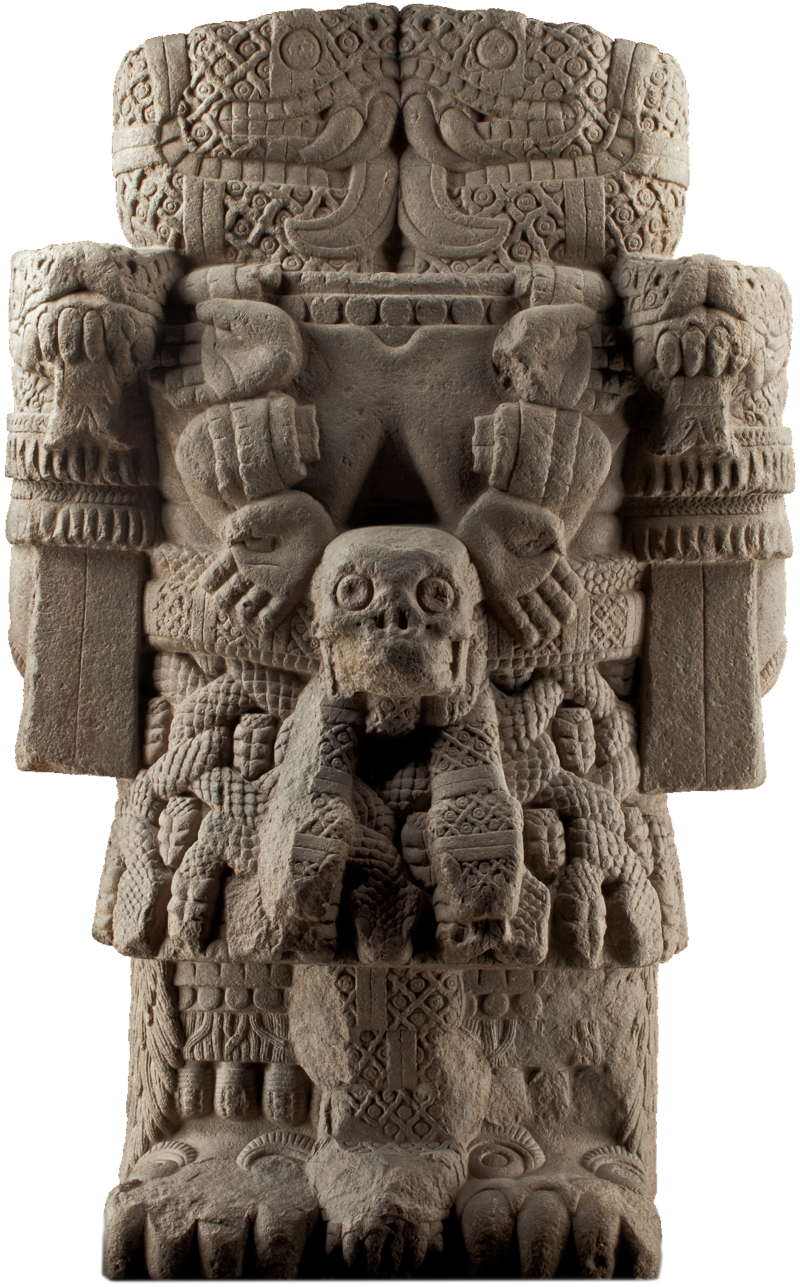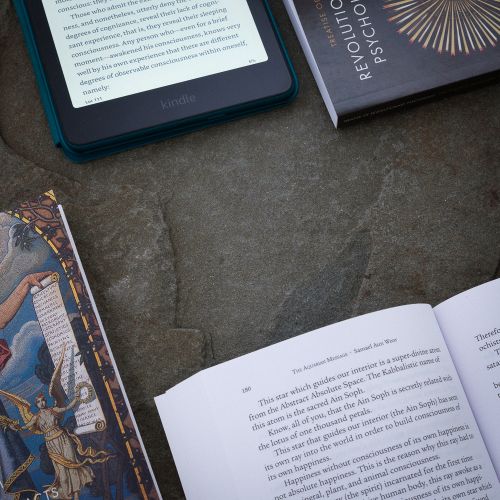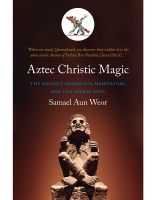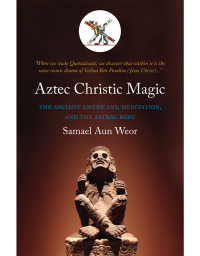Ometecuhtli-Omecihuatl, lord and lady of duality. Ome: two; tecuhtli: lord. Ome: two; cihuatl: lady. The entire universe emanated from this divine dual masculine and feminine principle. This god-goddess had four children, the four Tezcatlipocas: Xipe Totec,1 the red one; Tezcatlipoca,2 the black one; Quetzalcoatl, the white one; and Huitzilopochtli,3 the blue one. The four colors of the four races that presently populate the world were born from this divine and invisible binary.
Ometecuhtli has the presence of the Cosmic Christ. The Nahuas represent him with a beautiful, ornamented tunic and a flinted phallus, symbol of light. The entire presence of Omecihuatl is that of the cosmic virgin. The Nahuas represent her with an extraordinarily beautiful blue mantle and a skirt of occultation. He is Huehueteotl, the Old God, father of all gods and human beings. She is Tonantzin, our dearly beloved mother.
In the Museum of Anthropology and History in Mexico City, there is a monolith with an impressive tetra (fourfold) significance: On the apex of it, all the way through the ring of its entangled body, protrudes a precious and great two-headed serpent, which can be seen on the front and on the back like the God Janus of the Greco-Roman religion. The two-headed serpent’s eyes are round and penetrating; from their half-opened jaws (located under the four superior, curved, sharpened, protruded fangs) hang great and cleft tongues.

From its chest hang two flaccid breasts.
From shoulder to shoulder, this deity wears a leather necklace that is decorated with hearts, and is in the middle of four outstretched hands. At the height of the navel there is a skull that completes the necklace.
Its arms are stiffly located at each side, with forearms bent. Underneath its hands there appear superior, fang-like paws, which are actually heads of precious serpents with half-opened jaws. There hang smooth and geometrically cubic rectangles with a vertical line in the center of each one of its faces. All of this is a symbol of perfection of the deeds of its hands.
It has tiger paws and eagle eyes on its shoulders and elbows.
Its short skirt is made of intertwined serpents with their heads pointed downward. The skirt fits together at the waist by means of a wide belt made from precious serpents that are tied underneath the skull (whose wide-open eyes possess a threatening sight). On the belt, the serpent heads hang toward the front like two ends of a tie without a knot. This symbolizes that everything in the universe is the outcome of the sexual fire.
Nevertheless, the skull at the navel of this deity is neither the final touch of its necklace nor the brooch of its belt, but rather Coatlicue, the devourer of men, the goddess of earth and death, whose body projects from between the thighs of the deity toward the front and from the lower abdomen to the feet.
Many hearts and two streamers made of quetzal feathers adorn the sides of its underskirt that descend to its ankles and end in a wide fringe made of intertwined feathers. These feathers are adorned with badges from which sixteen long rattles hang. Between the four claws of each one of the feet of this deity, a sinuous and thick serpent shows off its jaws with claw-like upper incisors, and upon each one of the deity’s feet, in a bas-relief, are two eagle eyes that try to see to the infinite.
In the lower part, at the base or support of the sculpture, in bas-relief, we find Mictlantecutli4 with arms and legs opened as in the cross of Saint Andrew [an X]. In the posterior part, between its thighs, the creative fire protrudes downward from the lower abdomen. The mouth of the abyss is opened at its navel.
From its shoulders hangs a necklace with two hearts in the middle of four hands, which are opened in supplication toward the heights. The final touch is a marine knot adorned with four badges upon the vertebral column in between its hands.
On its back, at the height of the scapula, the skull, that looks as if it is fastened to the belt of her skirt of serpents, symbolizes Tonantzin, mother of the gods, who is hidden behind, in the posterior part of the skirt of Coatlicue, and who is forgotten by this present generation of humans. Her figure protrudes in the posterior part of this deity. She is dressed in a lace tunic that descends toward her feet and ends in a single and enormous claw, whose nails are seven elongated balls. This is an emblem of perfection and sacrifice.
From its necklace at the height of the thyroid hang two great flinted tongues, and upon her pectorals lies a laced tunic with six tassels which is the final touch. This is an emblem of creation.
On the front, underneath her pectorals, at the height of the lower abdomen, we find a streamer made of very fine arrows from which two great flinted tongues hang. The whole of these in their conjunction symbolize the universal fire of creation.
A “feeling of maternity” emanates from this precious serpent, which is the final touch to the whole combination of this monolith. Its double-headed face is the emblem of the divine couple. The posterior part from its shoulders to its feet symbolizes Tonantzin, the mother of the gods. Her chest, with flaccid breasts adorned with the necklace of hands and hearts, symbolizes Coatlicue, the shadow of Tonantzin.
Tonantzin is life; Coatlicue is death. The children of Tonantzin are children of the Holy Spirit and chastity. The children of Coatlicue are children of fornication and adultery.
The creative forces of Ometecuhtli-Omecihuatl express themselves during sexual union. These creative forces descend into the human organs of procreation with the exclusive goal that a new being appear in the physical plane. If the man and the woman unite themselves sexually only with desire, only for the animalistic desire of spilling the seminal liquor, then his solar forces and her lunar forces sink into the atomic abysses of the Earth and both convert themselves into slaves of the abyss. However, if love is what impels their sexual union and if they do not fornicate in their sexual caress, then, the precious serpent of quetzalli feathers awakens, agitates, and ascends in them toward its place of origin, transformed into Quetzalcoatl. This is how the couple is divinized.
On the threshold of the sanctuary of the temple, the masters present the initiate with a book within which is written all the Divine Mother’s laws. In front of this book, many withdraw in terror when they realize that they must kill their personality. Very few are they who pass the ordeal of the threshold of the sanctuary. Those who pass it receive a fine heavy gold ring, a symbol of power.
The initiate must die; he must cease being in order to be. Nevertheless, he must first return to the bosom of the Divine Mother and practice sexual magic with his chaste spouse, so that he can be spiritually born. The one who does not know the laws of the Mother will never reach the Father.
While in a rapture of love, when the mind and the mind of one’s beloved spouse is clean from any lustful thoughts, the man very softly introduces the phallus and caresses her with sweetness; thus, both must withdraw in time so as not to spill the seminal liquor. Likewise, by means of this amorous magic, the woman Self-realizes herself like the man. This formula educates the willpower to its highest degree of expression.
Practice
Ask with all your heart that the sacred fire of the Holy Spirit may descend upon you (read Luke 11:13).
The canals through which the seven fiery serpents ascend to the brain are: Sushumna, a septuple canal that extends itself throughout the middle of the spinal medulla up to the pituitary gland; Ida, a very fine canal that is located on the left side of the spinal medulla; and Pingala, located on the right side of it. Through them rises the sacred fire of the Holy Spirit to the pituitary.
To perform your meditation, take the comfortable position about which we previously advised you. After having placed your mind in a blank state, concentrate on the sacred fire of the Holy Spirit and see with the eyes of your soul that this fire arises from your prostatic (uterine) chakra toward your solar plexus, and at the same time through Ida and Pingala, which are located on either side of your spinal medulla. This exercise must endure for at least thirty minutes daily and must be performed at the same hour.
If you want success with these studies, you must neither drink alcohol, nor smoke, nor eat too much red meat. Do not worry; cultivate the habit of being happy.







